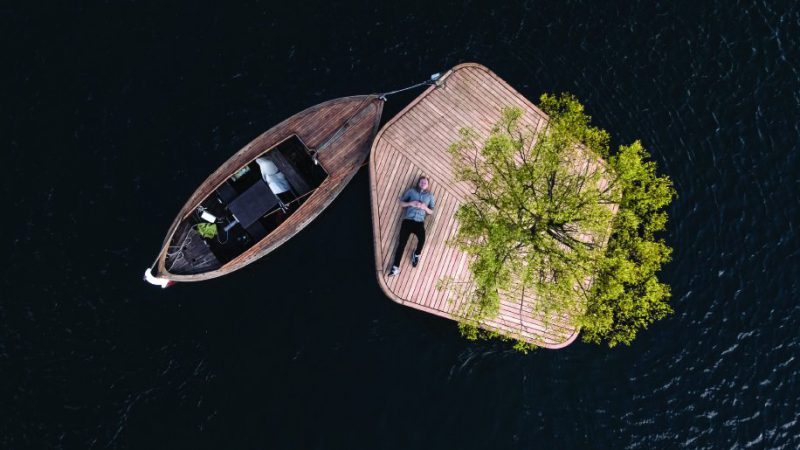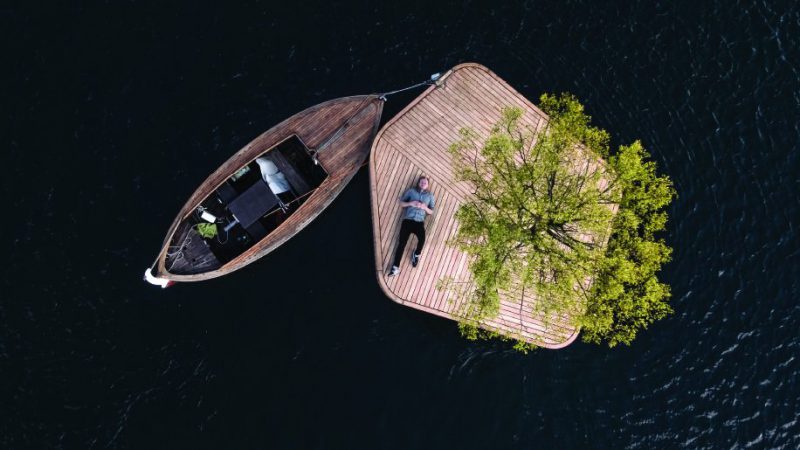The Hygge Life
The Danish capital combines business and pleasure with aplomb. Is Copenhagen’s progressive attitude at the heart of its success?
June 29, 2019


A high-heeled cyclist in a crisp suit passes me on the street, making a hands-free call as she pedals. It’s just after 3 PM on a Friday, and the concrete promenades lining Copenhagen’s three rectangular lakes – commonly mistaken for a single river – are baking in the unexpected spring heat.
At the nearby harbor, a powerboat carrying businesspeople guns down the satiny stretch of water towards Sweden. On days like this, “bridging” is also a thing in the Danish capital, where a denim-clad crowd perches along the walls of Dronning Louises Bridge, sipping cans of pilsner and socializing until sunrise.
You can’t possibly have made it through 2016 without hearing the word hygge (pronounced hue-gah). Just in case, it’s the Danish ideal of appreciating life’s simple pleasures: Family, friends, nature, soothing environments, a feeling of “a cozy togetherness.”
As a nation, Danes make time in their daily lives to appreciate the small but important things. It seems the rest of the world needs a manual to implement this – The Little Book of Hygge: the Danish Way to Live Well was a bestselling book in 2016. And since it consistently steals the top favorite spots of “most liveable” and “happiest” in worldwide city rankings, Copenhagen is certainly getting something right.
The enviable Danish lifestyle could be a trump card when it comes to attracting overseas talent. “I don’t think this factor should be underestimated,” says Claus Lonborg, CEO of Copenhagen Capacity, which supports foreign companies, investors and talent seeking opportunities in Greater Copenhagen.
“If you want to attract young talent, you need to offer a cool place to live, with the right framework for developing a business. Today, young people want to know: ‘What’s it like living in Copenhagen? Where can I hang out?’ They spend more time communicating about these things than about the actual job and company they’d be working for.”
Work-Life Balance
According to the “2017 Better Life” report from the Organization for Economic Cooperation Development (OECD), Danish people have one of the best work-life balances in the world, with only 2 percent regularly working long hours (more than 50 a week), compared to the international average of 13 percent. At the same time, in a study from Expert Market that divided the GDP of the world’s biggest economies by the number of hours worked per person, Denmark was ranked the fourth most productive country in the world (after Luxembourg, Norway and Sweden, respectively).What’s more, Denmark is consistently voted the best place in the world to be a woman – thanks to its flexible parental leave policy, its earnings-based childcare system and its active promotion of gender equality. To top it all off, national healthcare and education are virtually free.
A Scandi State of Mind
It’s easy to paint Denmark as a utopian urban paradise when, of course, not everything is rosy. Immigration policies continue to be an issue, and its normally buoyant economy appears to have softened a bit in the first quarter of 2019.
But overall, Denmark’s progressive nature has created a society that outsiders look upon with admiration, and a fitting business environment for blue-sky thinking. A key aspect of this is Denmark’s digitized lifestyle, which cultivates great conditions for launching and testing new products.
“The Danish government committed to the digital agenda early on,” says Lonborg. “Everything from renewing your passport to getting a work permit has been completely digitized. As a citizen, if every time you interact with your government, it’s digital; you automatically become much more tech savvy, which develops quite an interesting test market for new technologies. I think that savviness is what’s driving and inspiring people here.”
Skype (a joint venture with Stockholm-based entrepreneurs), Unity (the creators of the leading global platform for building computer games) and Just Eat are some of the success stories from Copenhagen’s thriving tech sector, each of them unicorns (companies valued at more than $1 billion). Major IT corporations have a presence in the city, including IBM, Microsoft and Google, which has its Nordic headquarters here. What’s more, the University of California established its first out-of-state university campus in the Danish capital.
How do Copenhagen’s startup conditions compare to the other Scandinavian capitals? “There are probably more similarities between the Nordic countries than there are differences,” says Lonborg. “We have so much shared history and culture. Having said that, there are a few ways in which Copenhagen stands out. We have the best-connected airport in the Nordic region. In a regional context, we’re not that expensive. And it’s very easy to work with the authorities,” he explains.
“We also have what we like to call ‘flexi-curity’ in Denmark,” he adds. “We are one of the countries in the world where it’s the easiest to hire and fire people. Investors know that you may not be successful in the first rounds of funding, so you have to be able to scale up or down if needed. It’s much more difficult in Sweden, France and elsewhere in Europe, which costs companies money and time.”
Furthermore, in a highly publicized, landmark move, the Danish government has announced plans to integrate the sharing economy into its federal tax and labor laws. Although ride hailing service Uber was booted out of Denmark last year for failing to comply with the existing regulations, Airbnb recently agreed to report all homeowners’ incomes from the home rental company to the Danish authorities. Their compliance will help crack down on tax evasion (a massive no-no in a country where the average citizen hands over 45 percent of their income to the public purse).
In addition, Airbnb will limit the number of days that Danish homeowners can list their property to 70 days per year. In return, the government will give people letting their homes via Airbnb a tax-free allowance of up to 40,000 kroner ($6,061) a year. This happy medium could set a precedent for countries all over the world, which are also accepting that the sharing economy enterprises are here to stay, but seeking a solution to reign them in and make them behave more like traditional businesses.
Grand DesignsThe international fervor for all things Scandi has steadily bolstered tourism to Copenhagen, and served the city’s hotel industry well. “We’ve seen this tremendous increase in tourism – we hotels have had a pretty good time over the past five years,” says Peter Borup, director of Copenhagen Strand hotel.
“All Copenhagen hotels here have undergone some kind of renovation during this time. And now international investors are looking at Copenhagen. Projects are underway that will increase the number of rooms by about 40 percent over the next three or four years.”
Recent visitors to the Danish capital will also have noticed the drilling and construction taking place in the city’s pretty public squares, and the miles of fencing painted with edgy artwork in an attempt to compensate. The development of a new metro line, Cityringen, has been a long time coming.
Reportedly scheduled to open this month, the automated trains on the circular route will connect the districts of Vesterbro, Norrebro and Osterbro. Afterwards, the line will also be extended by lines branching off to the north (Nordhavn extension, coming 2020) and to the south (Sydhavn, coming 2023).
In a rather nifty move, the soil dug up during the construction of the new metro line has been converted into reclaimed land – forming the new floating business and residential district where the Nordhvn line will terminate. Situated in the city’s North Harbor, Nordhavn is loaded with swanky apartments and industrial charm.
Speaking of floating, Copenhagen’s harbor has gained a rather intriguing addition – a wooden island sprouting a single linden tree. Designed by Australian architect Marshall Blecher and Magnus Maarbjerg from Danish design studio Fokstrot, the 200-square-foot structure is not only a resting place for kayakers and open-water swimmers, but it doubles up as event space, and was used to host talks about the future of harbor cities.
It’s intended to be the first of a “parkipelago” – a network of nine islands that will add interest and activity around Copenhagen’s waterways. The idea is for them to be connected together for festivals or events, each one different: a sail-in café, a diving board, a mussel farm, a stage and a sauna are among the current plans.
“The harbor has been cleaned up so that it’s fully approved for swimming, and we’ve established outdoor facilities where you can take a dip after work,” says Lonborg. “How many cities around the world are there where you can live downtown and swim in the harbor?”
At dusk, I stroll up to Islands Brygge, the city’s original “harbor bath.” The winding walkway connects to the wide promenade, creating sectioned-off areas of crystal clear water. A few swimming-capped heads bob in and out of the water, while the walkways are teeming revelers, munching on barbecued snacks from a food truck and chattering over the sounds of a brass band, living the hygge life. Seeing the city at its best, it’s undeniable that Copenhagen has the right DNA for being the world’s happiest city.




